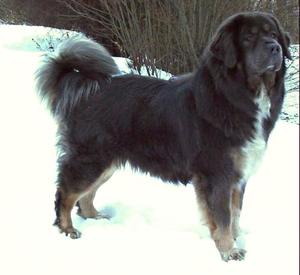
Hailing from the foothills of the Himalayas, the Tibetan Mastiff is considered to be one of the oldest breeds in existence, with Chinese records indicating it made its first appearance as early as 1100 BCE. Falling within the Kennel Club's 'working' group, the Tibetan Mastiff was primarily bred as a livestock guardian, often travelling with nomadic herdsmen to guard their flocks or else remaining in the villages to protect the home and property. In its early years it was common practice for the Tibetan Mastiff to be tethered during the day, usually to enhance its aggressive nature, and then released at night to protect the homestead. Recognised by the American Kennel Club in 2006, the breed is now rare in native Tibet, whilst being favoured in the United States as an all-purpose farm dog.
A stocky and powerful-looking breed, boasting strong legs, a deep chest for aiding stamina, a broad head with a deep, square-cut muzzle and pendant ears. Characteristically robust rather than tall, the Tibetan Mastiff is impressive in size and stature. The profuse double coat is typically coloured black brindle, brown or blue-grey, usually with gold or tan markings, although white markings are not uncommon. The topline is level and the heavily feathered tail arches over the back. A lion-like mane makes the breed very distinctive.
Often described as a 'gentle giant' by Mastiff owners, the breed is deceptive in appearance, suggesting a fierce fighter dog, whilst being inherently gentle. Responding fearlessly if danger threatens, the Tibetan Mastiff will otherwise remain docile and mannered, displaying a pleasant and easy-going temperament that makes it well suited to domestic living. Devoted to children, the Tibetan Mastiff makes a great breed choice for families. On average, a fully grown Mastiff will weigh 64-78 kg with large discrepancies across gender, with a life expectancy of 10-15 years.
Despite suffering from fewer genetic disorders than other breeds, the Tibetan Mastiff is still susceptible to several conditions, ranging in severity. From hip dysplasia and associated orthopedic complaints, to thyroid problems, ear infections and skin conditions, the Tibetan Mastiff does not come without its health issues. Cardiac problems, epilepsy and dental disease are also well documented in the breed.








From Northumberland, United Kingdom
A primitive breed, only suitable for those with experience of large guardian-type breeds and able to provide the right environment. Endlessly fascinating and rewarding if you are the right person, but I think the breed description here is a bit misleading: they can indeed be great family dogs, but are a much greater challenge than this phrase implies. Some have a very strong guarding instinct, even when very well socialized. Read up on the breed and speak to a few owners and breeders, and the breed club if you are considering one.
my boy is great out and about but very protective when hes home behind the gate
From Nottinghamshire, United Kingdom
My pup is very well socialized, loves dogs, kids and specially the ladies lol. Very protective of the property. Very well relaxed outside when we take a cafe break.